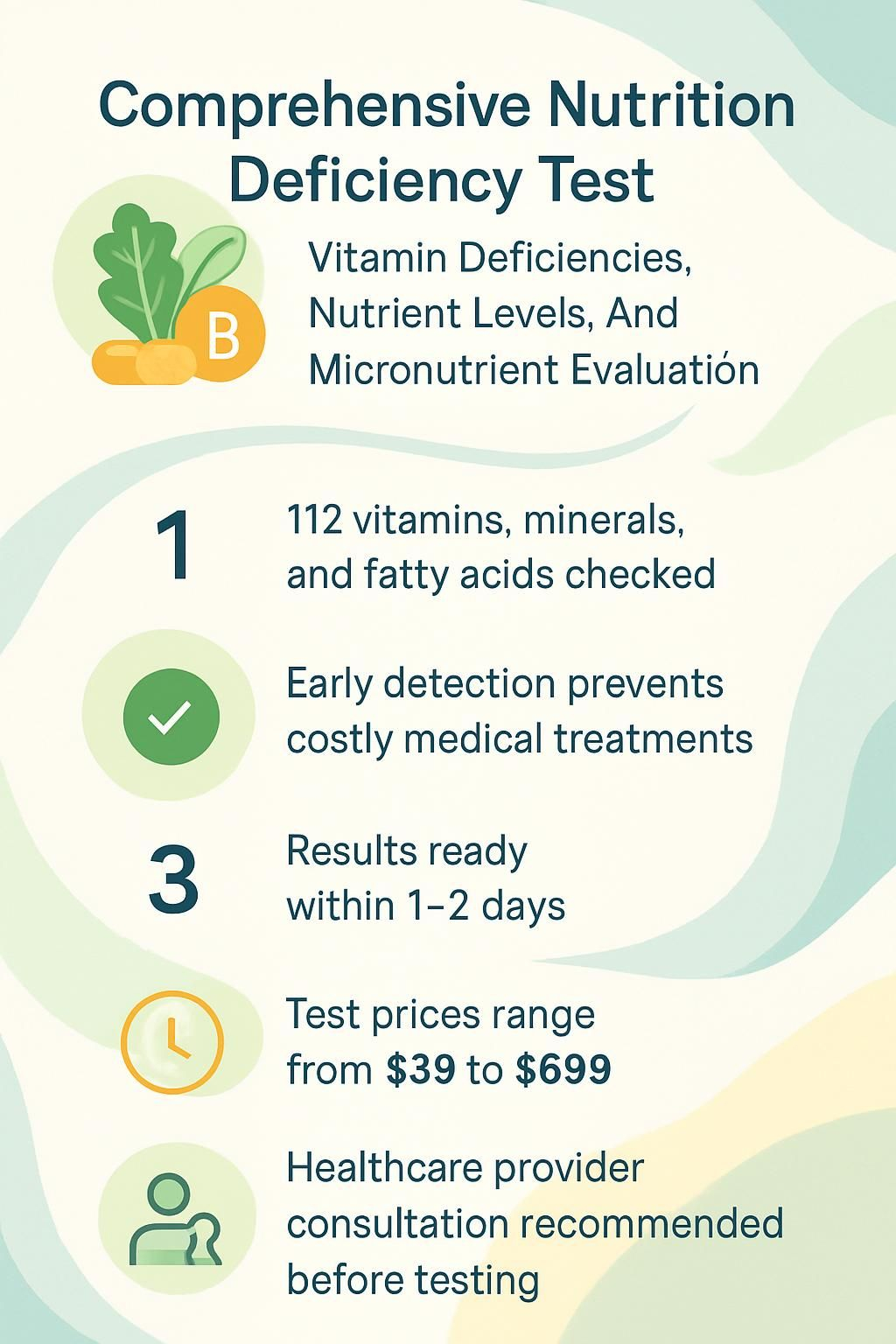Comprehensive Nutrition Deficiency Test: Vitamin Deficiencies, Nutrient Levels, And Micronutrient Evaluation
Our Nutrition Assistant AI Suite will transform your body. You will lose fat, get toned, and build muscle. Gain confidence and optimal health.
Feeling tired, weak, or noticing changes in your hair and skin can be confusing. Often, these signs point to hidden vitamin deficiencies that a comprehensive nutrition deficiency test can uncover. With options like Labcorp OnDemand, you can measure essential nutrients and review clear test results online. This guide explains test types, what they measure, how they work, and what your symptoms might mean.
Start looking for answers about nutrient deficiencies today.
Key Takeaways
- A comprehensive nutrition deficiency test, like Labcorp’s $239 Micronutrient Test or 5Strands’ $59 hair analysis, checks up to 112 vitamins, minerals, and fatty acids to uncover hidden gaps.
- Early detection of low vitamin D, B12, iron, or magnesium can prevent fatigue, bone pain, heart issues, and higher medical costs later.
- Blood, urine, hair, and nail samples deliver accurate results in about 1 to 2 days, with secure online reports through Labcorp Patient™.
- Popular panels include diet-specific, inflammatory, and oxidative stress tests, with prices ranging from $39 for single nutrients to $689 for healthy aging analysis.
- Consult a healthcare provider before testing to choose the right panel, interpret results, and plan safe, effective steps to improve your nutrient status.

What is a Comprehensive Nutrition Deficiency Test?

A comprehensive nutrition deficiency test checks your body for essential vitamins, minerals, and other key nutrients. Most panels use a blood sample, and some include urine, hair, or nail analysis for a fuller view.
For example, the 5Strands Nutrition Test examines up to 112 nutrients using hair. Labcorp’s Micronutrient Test costs $239, and its Custom Micronutrient Test is $485. These tests assess vitamins like vitamin D, B12, and folate, plus minerals such as magnesium, zinc, iodine, and amino acids.
A nutrient deficiency panel helps you identify specific micronutrient gaps that may affect health.
Lab results show if you have mild, moderate, or severe deficiencies, or signs of poor absorption. Testing takes place in CLIA-certified laboratories that follow strict quality standards for accuracy.
You can purchase a health test online. After you submit your sample at home or at a lab location such as Labcorp OnDemand Testing in the United States, results appear in your secure Labcorp Patient™ account.
Why is it important to identify vitamin and nutrient deficiencies?
Finding vitamin and mineral deficiencies early helps you maintain nutritional health and prevent bigger problems. A comprehensive nutrition lab test can guide simple changes that help you feel your best.
How can early detection prevent health issues?
Quick lab testing, including options from Labcorp, often returns results within 1 to 2 days after your sample arrives. Fast feedback lets your clinician act before symptoms grow worse.
For instance, spotting low iron can prevent anemia. Finding low vitamin D early can protect bone strength. Routine blood work and screening lower your risk of fatigue, bone pain, and cramps. Adjusting your diet or using supplements after a deficiency is found helps stop larger issues from developing.
Timely action may also reduce expensive treatments later and supports healthier aging, including better immune and heart health. The $689 Healthy Aging Test highlights the value of ongoing monitoring as you get older.
How do nutrient deficiencies contribute to chronic diseases?
Low vitamin D, B12, and iron raise the risk of anemia, osteoporosis, and cardiovascular disease. Inadequate magnesium or zinc increases the chance of inflammatory conditions.
The $189 Anemia Test checks for iron problems that cause constant tiredness. Long-term gaps can weaken the immune system, which is why many people choose Labcorp’s $219 Standard Immunity Test.
Micronutrient imbalances can affect blood sugar control, which ties to diabetes. The $189 Diabetes Management Test tracks how nutrition gaps may impact glucose levels. Malabsorption syndromes, such as celiac disease, detected with the $119 Celiac Disease Antibody Test, can lead to ongoing shortages.
Even mild vitamin or mineral deficiencies can trigger a chain reaction that leads to long-term health problems.
How does identifying deficiencies enhance overall well-being?
Correcting deficiencies supports your body’s systems and improves daily life. Vitamin deficiency tests and micronutrient panels can address low energy, mood changes, hair loss, skin issues, and digestive discomfort before they escalate.
The Fatigue Test connects nutrient status with tiredness and low motivation. Many people report better energy after fixing gaps. Nutrition improvements can support immunity, focus, healthy weight, and fertility. Clinicians use laboratory tests to offer personalized steps that optimize nutrition at any age.
Types of Nutrition Deficiency Tests
Different test types can confirm nutrient and vitamin deficiencies and give a clear picture of your nutritional health.
What are blood tests for nutrient deficiencies?
Blood tests measure levels of important vitamins, minerals, and other markers directly in the bloodstream. Labcorp panels often rely on blood, which makes them highly accurate for finding deficiencies.
Examples include a Vitamin D Test for $99 and a Vitamin B12 Test for $49. A Magnesium Test costs $39, and ferritin can help assess iron storage. CLIA-certified labs run these tests under strict quality assurance standards.
The $169 Comprehensive Health Test reviews multiple markers from one sample. The $99 Standard Health Test covers basics. Some panels also evaluate metabolic function, inflammation, oxidative stress, thyroid hormones like the $89 Standard Thyroid Test, and iodine levels.
Turnaround is commonly 1 to 2 days after the lab receives your sample. Results are available online in your Labcorp Patient™ account. If urine testing is recommended, it can provide added context about what your body excretes.
How do urine tests detect nutrient levels?
Urine tests assess how much of certain vitamins, minerals, or their byproducts your body eliminates. Labcorp offers an Urine Analysis Test for $49 to review kidney health and potential micronutrient issues.
The Kidney Health Test, $99, reviews renal markers affected by nutrient status. The Albumin to Creatinine Ratio Test, $79, also uses urine to gauge kidney function. Urine testing often works alongside blood testing for a fuller picture. Some panels use urine to check hormone metabolites or B vitamin excretion. Drug screens, such as the $169 Complete Drug Test and $109 Standard Drug Test, also rely on urine when needed.
What is hair and nail analysis in nutrient testing?
Hair and nail analysis uses small samples to examine vitamin, mineral, and amino acid patterns over time. The 5Strands Nutrition Test checks 112 nutrients using a single hair sample, costs $59, and delivers results in about four days.
Functional medicine providers often use this method to spot absorption problems that blood work can miss. Hair and nails grow slowly, so they reflect longer-term nutritional trends. Brittle nails or ongoing hair loss can signal issues like low biotin, also called vitamin B7.
At-home collection is simple, and you can mail a small sample without an office visit. I used an at-home hair test when my energy stayed low despite normal blood work, and it helped explain what I was missing.
Key Nutrients Assessed in Deficiency Tests
A nutrition deficiency test reports on key vitamins and minerals. Panels measure levels in the blood to identify gaps that may affect your health.
Which vitamins are commonly tested?
Clinicians often check several vitamins to detect potential deficiencies and guide your plan. These tests can flag nutrition gaps before symptoms appear.
- Vitamin D, measured with a 25-hydroxy vitamin blood test for about $99. Low levels can cause bone pain and muscle weakness and increase risks like arrhythmia.
- Vitamin B12, priced at $49, supports nerves and red blood cells. Low levels are common in people with Crohn’s disease, celiac disease, or vegan diets.
- Vitamin C, often $59, supports immunity and helps reduce fatigue and dry skin.
- Vitamin E, at $69, can highlight gaps linked to nerve or muscle pain and is important for pregnancy and red blood cell function.
- Vitamin A, about $59, supports vision, growth, and immunity. Shortfalls may cause skin and bone health issues.
- Folate is included in broad panels, such as the $169 Vitamin Deficiency Test, which checks D, B12, and folate together for issues tied to red blood cells and heart rhythm.
- Vitamin K may be measured in advanced panels to assess blood clotting and bone health, especially if you have digestive problems or take antibiotics.
- I once had a full blood panel, and the results helped my clinician adjust my meals to include more plant-based foods. My energy and bone strength improved within a month.
What are the important B-complex vitamins to assess?
B-complex vitamins help with energy, metabolism, and the nervous system. Many comprehensive tests, including the $89 Vitamin B12 and Folate Test, review these key nutrients for warning signs.
- Thiamine (B1): Converts food to energy and supports nerve function. Low levels can cause fatigue or nerve problems.
- Riboflavin (B2): Supports metabolism as a cofactor in many reactions. Low levels may lead to skin issues or sore throat.
- Niacin (B3): Supports digestion, skin, and nerves. A severe lack can cause pellagra with dermatitis and diarrhea.
- Pyridoxine (B6): Needed for brain development and immune response. Shortages can cause anemia, rashes, or nerve issues.
- Folate (B9): Vital for cell growth and red blood cell formation and works closely with B12. Low folate can cause anemia and is important during pregnancy.
- Cobalamin (B12): Needed to make DNA and keep nerves healthy. People who avoid animal foods often need testing.
- Comprehensive Health Tests, $169, often include B1, B2, B3, B6, B9, and B12 to give a complete snapshot.
Testing these vitamins can reveal risks related to your eating pattern, whether plant-based or meat-heavy. Next, you will see which minerals show up in most panels.
Which minerals are included in deficiency panels?
Minerals support bones, immunity, fluid balance, and metabolism. Here are common minerals measured in deficiency panels:
- Calcium supports strong bones and teeth. A typical test is about $79 and helps check for dehydration or low bone density.
- Iron moves oxygen and powers energy production. An iron test may be $59, and a ferritin test checks stored iron if fatigue is a problem.
- Magnesium affects muscles, heart rhythm, and nerves. A $39 test can help explain cramps or weakness.
- Zinc supports immune function and healthy skin and nails. Testing is often around $69, and is helpful if wounds heal slowly.
- Copper helps red blood cell formation and nervous system health. A copper test is usually about $59, which can help evaluate Wilson’s disease or Menkes disease.
- Selenium acts as an antioxidant. Testing, often $109, helps assess thyroid function and related concerns.
- Iodine regulates thyroid hormone production and energy. An iodine test may cost $69 and is useful if you have fatigue or hypothyroid symptoms.
When I felt worn out all the time, a comprehensive panel at a CLIA-certified lab showed low ferritin. Treating low iron storage helped my energy return.
Mineral testing can explain symptoms like hair loss, cramps, or brittle nails and ensures you have enough vitamins and minerals for daily health.
Why are fatty acids like Omega-3 and Omega-6 tested?
Omega-3 and Omega-6 fatty acids support cell membranes, hormone pathways, and inflammatory balance. Unbalanced levels may raise inflammation and heart risks. Panels often include these markers because they influence brain, eye, and heart health.
Diet-specific panels, such as vegan or keto options, commonly assess fatty acids to catch gaps early. The $89 Weight Management Tracking Test also reviews these markers, which can guide food choices based on your results from a CLIA-certified lab.
Next up: common symptoms of nutrient deficiencies and when to consider testing.
What are common symptoms of nutrient deficiencies?
Many symptoms of vitamin or mineral shortages are easy to miss. Knowing these signs helps you act sooner.
How do fatigue and weakness indicate deficiencies?
Fatigue and weakness are warning signs that you may lack key vitamins or minerals. Low iron, found with a Ferritin Test or Iron Levels Test, can make you feel exhausted even with good sleep.
Anemia Tests identify weakness linked to low red blood cells. A shortage of B12 or folate leads to chronic fatigue because these nutrients help your body make energy. A Magnesium Test, $39, may reveal low magnesium if muscles feel weak.
Persistent tiredness is a common reason to order the $159 Fatigue Test or the $169 Comprehensive Health Test. I once felt weak and unfocused for weeks. Testing showed low vitamin D, and updating my plan improved energy quickly.
Can hair loss and brittle nails signal nutrient issues?
Hair loss and brittle nails often point to nutrient problems. The 5Strands Nutrition Test and the $169 Vitamin Deficiency Test both examine nutrients tied to hair and nail strength.
CLIA-certified labs analyze these samples for accuracy. Poor absorption of zinc, iron, or selenium can weaken hair. Brittle nails may signal low calcium, magnesium, or protein intake. The $219 Women’s Health Test reviews markers related to nail and hair health and checks hormone levels that affect nutrient needs.
Both men’s and women’s panels include nutrients linked to skin, hair, and nails. Hair analysis may spot mild diet-related changes and more serious issues, including those tied to inflammatory bowel disease. Simple nutrition changes restored my nail strength after a test uncovered low calcium last year.
What skin problems relate to nutrient shortages?
Dry skin often shows up when nutrients are low. The 5Strands Nutrition Test flags dryness as a symptom to watch. Shortfalls of vitamins A, C, and E can harm skin barrier function and slow wound healing.
Zinc deficiency may cause rashes and delay recovery. A $69 Zinc Test helps identify this quickly. Ongoing skin problems can also relate to low selenium, checked with a $109 Selenium Test. Persistent vitamin D deficiency adds to skin concerns, so consider a $99 Vitamin D Test.
If you suspect food triggers, the $359 Comprehensive Food Allergy Test can reveal hidden sensitivities. For rashes, dryness, or slow healing, the $169 Comprehensive Health Test reviews the key nutrients that keep skin resilient.
How are bone pain and muscle cramps connected to deficiencies?
Bone pain and muscle cramps often point to vitamin and mineral shortfalls. Low vitamin D or calcium can cause aches in bones. A $99 Vitamin D Test or $79 Calcium Test measures these levels.
Frequent cramps can result from low electrolytes. Low magnesium, potassium, or calcium can cause cramps and spasms. An Electrolytes Test runs $49, and a $39 Magnesium Test helps pinpoint the cause. Anemia can also lead to bone discomfort. The $189 Anemia Test checks iron-related markers along with a complete blood count. The $89 Standard Thyroid Test may help diagnose muscle and bone symptoms tied to hormone balance.
As an endurance athlete, I once had nightly leg cramps. Blood tests showed low magnesium and borderline B vitamin levels. After adjusting my diet and taking targeted supplements with my provider’s guidance, the cramps faded in a few days.
Popular Nutrient Deficiency Test Panels
Comprehensive panels measure many vitamins and minerals with one sample and deliver easy-to-read results online.
What do comprehensive vitamin panels include?
Comprehensive vitamin panels review a wide range of nutrients for a complete view of your status.
- Most panels measure vitamin D, including forms that affect bone strength and immune function.
- Vitamin B12 and folate appear together since they are important for nerves and energy and can influence neurological risk when low.
- Water-soluble vitamins like vitamin C and several B vitamins help address fatigue and weakness linked to shortages.
- Minerals such as iron, magnesium, calcium, and zinc are included because they support metabolism and organ function.
- Advanced panels often assess Omega-3 and Omega-6 fatty acids that regulate inflammation and cardiovascular health.
- Diet-specific add-ons may target vegan or keto needs and help identify gaps from restricted eating patterns.
- Women’s Health Tests, $219, and Men’s Health Tests, $219, include expanded vitamin profiles relevant to sex-specific needs.
- Some panels add markers of oxidative stress or inflammation to catch hidden risks that connect with micronutrient status.
- Results often arrive online within 1 to 2 days after sample receipt, which speeds decisions.
- The $169 Comprehensive Health Test measures multiple nutrients with a single blood draw to save time.
- At-home kits are compact, which helps with mailing if you choose a home collection option.
What is evaluated in micronutrient panels?
Micronutrient panels go deeper than standard vitamin checks. They evaluate vitamins, minerals, and other cofactors to give a fuller picture.
- Minerals such as magnesium, zinc, and iodine are measured because low levels can drain energy and affect health.
- B-complex vitamins like B12 and B6 support metabolism and the nervous system.
- Fat-soluble vitamins, including ergocalciferol (vitamin D2), help assess bone and immune health.
- Omega-3 and Omega-6 levels show if inflammation or heart risks might be higher.
- Antioxidants like vitamin C and selenium help protect cells from oxidative stress.
- Advanced panels may include absorption markers to reveal how your body uses nutrients, not just what is circulating.
- Amino acid checks support insight into muscle repair and immune function.
- Consumer-initiated tests like 5Strands offer hair-based options that are noninvasive and convenient.
- Reports flag mild, moderate, or severe imbalances so you can target diet and supplements precisely.
- Clear summaries often include food suggestions that match your specific gaps.
My panel once showed mild zinc deficiency and low vitamin D2. Simple changes improved mood and energy within two months.
Which diet-specific panels are available (e.g., vegan, keto)?
Diet-specific panels match your eating style and help you spot likely gaps.
- Vegan panels focus on vitamin B12, iron, calcium, vitamin D, and Omega-3 fatty acids. These nutrients are critical for energy, bones, and brain health.
- Keto panels review electrolytes, magnesium, zinc, and vitamin D to spot common low-carb risks and guide balance.
- Each panel provides targeted testing based on your diet history, using blood, urine, or hair samples.
- The $485 Custom Micronutrient Test lets you select specific nutrients based on your pattern of eating.
- The $149 Weight Management Baseline Test adapts results to plant-based, keto, or other diets and checks if you have needed vitamins and minerals for weight goals.
- These panels help you prevent gaps tied to restrictive eating by guiding supplement and food choices.
- Quest laboratory panels measure vitamins, minerals, and fatty acids that match your nutrition style, such as Omega-3 for vegans and magnesium for keto.
- At-home kits protect privacy, and results are shared securely through email and private portals.
- Many kits arrive in a compact box, roughly 7 x 0.65 x 5 inches, which is easy to ship and store.
- Choosing the right panel depends on your diet, symptoms, and goals. Healthcare professionals can help fine-tune your selection.
What do inflammatory and oxidative stress panels assess?
Inflammatory and oxidative stress panels check markers that reveal inflammation and antioxidant status. These markers help predict chronic disease risk and guide targeted diet strategies.
- Inflammation panels include C-reactive protein and pro-inflammatory cytokines that rise with infections, autoimmune conditions, or metabolic disease.
- The $329 Comprehensive Heart Health Test measures key inflammatory markers tied to heart risks.
- Oxidative stress panels often check vitamin E, $69, selenium, $109, and broader antioxidant status to assess protection against cell damage.
- Find out your risk for chronic conditions tied to inflammation and plan nutrition steps to reduce it.
- Labcorp offers blood-based panels that give reliable data for your provider to interpret.
- Results show whether you should adjust your nutrition plan or check for absorption issues.
Next, learn how the testing process works from start to finish.
How does the testing process work?
A comprehensive nutrition deficiency test measures levels of vitamins, minerals, and other nutrients. Results point to gaps that can affect daily function and long-term health.
Why consult a healthcare provider before testing?
Healthcare providers help select the most relevant test based on your symptoms and history. They review medications to avoid interactions and unnecessary testing.
If you have a chronic condition, medical oversight keeps testing safe. Clinicians interpret complex results so you get an accurate diagnosis and not self-diagnosis. My clinician once recommended a blood panel when I felt worn down. It stopped me from guessing and led to the right plan faster.
Medical disclaimer: This article is educational. It is not a substitute for personalized medical advice. Always work with a qualified clinician for diagnosis and treatment.
How do you provide samples for nutrient tests?
Follow the collection steps closely so your results are valid. Here is a simple checklist.
- Read all instructions before you collect. This reduces errors and keeps results accurate.
- Register your test or at-home kit online so your sample links to your account.
- Go to a Labcorp site for a blood draw, or use a finger prick if permitted. Fasting may be required.
- Use the provided containers for urine tests, such as the $49 Urine Analysis or $79 ACR Test, and follow timing and storage rules.
- Cut hair near the scalp for the 5Strands Nutrition Test, $59. Most kits need about 1 gram of hair.
- Clip clean fingernails or toenails for nail analysis and place them in the correct envelope.
- Use prepaid shipping to send samples to CLIA-certified labs for reliable processing.
- Check if you should fast or pause certain supplements before collection since they can affect readings.
- Pack your sample in the compact kit box, often around 7 x 0.65 x 5 inches and about 1.76 ounces.
- Most at-home kits include clear, step-by-step instructions.
- I found hair collection simple at home, and prepaid shipping made the process quick.
How should you interpret your test results?
Access results in your Labcorp Patient account. Each nutrient appears with a reference range so you can see where you stand.
Reports mark deficiencies as mild, moderate, or severe. If anything is critical, Labcorp contacts you directly. Review results with a healthcare professional before changing diet or supplements. Some findings require urgent care or further evaluation for absorption problems.
What are the benefits of comprehensive nutrient testing?
Comprehensive testing gives a clear view of your micronutrient status. Accurate data helps you make precise changes that support overall health.
How can testing lead to personalized dietary advice?
Results highlight specific gaps, like low B vitamins or Omega-3 fatty acids. Your clinician can turn that data into practical meal and supplement advice that fits your daily routine.
The $485 Custom Micronutrient Test provides an individualized assessment that shows exactly where support is needed. The $149 Weight Management Baseline Test can also be used to align recommendations with vegan, keto, or flexible diets.
After my 5Strands test, I adjusted meals based on the findings instead of guessing. That shift prevented repeat issues and supported better energy.
What health improvements come from nutrient testing?
Correcting vitamin and mineral gaps often boosts energy, mood, skin, and focus. Many people see fewer cramps, less bone pain, and reduced hair loss once key nutrients return to healthy ranges.
Hormone and fertility measures may improve with proper nutrient intake. Clinicians report fewer cases of anemia, osteoporosis, and cardiovascular problems among patients who manage nutrient levels well. A stronger immune response and better outcomes in diabetes or thyroid disorders are common with targeted nutrition.
How does testing reveal nutrient absorption problems?
Testing shows actual levels, which helps you see if absorption is the issue rather than intake. For example, a blood test might show low B12 or iron despite eating enough. Hair analysis, such as the $59 5Strands test, can show patterns that suggest chronic malabsorption.
Symptoms like brittle nails, inflammation, or sudden hair loss often match lab findings. Some panels grade the severity of absorption issues. If tests point to malabsorption, clinicians may suggest gastrointestinal evaluation and ongoing monitoring, not just diet changes.
I took a panel after weeks of fatigue and brittle nails even with a balanced menu. The results showed a moderate magnesium deficiency linked to gut issues. My treatment plan focused on both supplementation and medical care, which worked better than diet alone.
How to choose the right test for your needs
Choosing the right comprehensive nutrition deficiency test depends on your symptoms and health concerns. Exploring your options helps you get the best insight.
Read more to see how these tests support better health and well-being.
How do symptoms and health concerns guide test choice?
Specific symptoms help clinicians pick the right tests. For constant fatigue or hair loss, the $169 Vitamin Deficiency Test or ferritin testing can confirm whether low vitamins or iron are involved.
Bone pain or cramps may call for a $79 Calcium Test, a $39 Magnesium Test, or a $49 Electrolytes Test. Skin concerns such as dryness or rashes suggest a $59 Vitamin A Test, $59 Vitamin C Test, or $69 Zinc Test.
Fertility questions point to the $199 Men’s Rapid Fertility Test or the $219 Women’s Fertility Ovarian Reserve Test. Chronic disease risks may require a $329 Comprehensive Heart Health Test or a $39 Diabetes Risk Test. For immune issues, the $219 Standard Immunity Test or $129 MMR Immunity Test can help. If poor absorption is suspected, consider the $59 5Strands Nutrition Test, which ships in a compact kit.
What test panels are available to explore?
Your symptoms and goals will guide your choice. Frequent tiredness, hair loss, or infections can point to specific panels.
The $169 Vitamin Deficiency Test checks key vitamins linked to energy and wellness. The $239 Micronutrient Test evaluates multiple vitamins, minerals, and cofactors used by the body. The $169 Comprehensive Health Test covers general markers, while the $99 Standard Health Test provides a basic snapshot.
Hormone-focused options include the $159 Comprehensive Testosterone Test and $79 Estradiol (E2) Test. For immunity, the $69 Hepatitis B Immunity Test and $69 COVID-19 Antibody Test are available. Fertility panels include the $219 Women’s Fertility Ovarian Reserve Test and $199 Men’s Rapid Fertility Test.
For heart health, consider the $329 Comprehensive Heart Health Test or the $69 Apolipoprotein B Test. If allergies are a concern, the $359 Comprehensive Food Allergy Test and the $99 Dog and Cat Allergy Test can be helpful. For weight goals, the $149 Weight Management Baseline Test and $89 Tracking Test support ongoing monitoring.
I purchased a Micronutrient Test after months of slow workout recovery. It showed low vitamin D and Omega-3. With my clinician’s help, I changed my plan and felt better within weeks.
Why consult healthcare professionals before testing?
Professional guidance helps you avoid wasted time and duplicate testing. Providers use your history and medication list to select the most useful panel for vitamin deficiencies, mineral levels, or overall micronutrient status.
They also reduce risks from self-supplementing and protect your privacy rights. Some shortages require prescriptions, not over-the-counter options. Providers can schedule follow-up testing to make sure changes are working and to manage complex cases where multiple nutrients interact.
Popular At-Home Testing Kits
Many at-home testing kits let you check nutrient levels from home. These tools can catch vitamin and mineral gaps earlier and support simple tracking.
What features and benefits do at-home kits offer?
- Collect small blood or urine samples at home with clear instructions and avoid waiting rooms.
- Receive results online in 1 to 4 days after the lab receives your sample.
- CLIA-certified laboratories process samples to ensure reliable results.
- Evaluate up to 112 nutrients, including vitamins, minerals, cofactors, and fatty acids, to spot gaps.
- Some kits can flag absorption issues that standard blood work may overlook.
- Kits use simple, compact packaging. The 5Strands box measures about 7 x 0.65 x 5 inches.
- Adults across age groups use these kits to check for diet-related deficiencies.
- Results prompt better conversations with providers who can shape evidence-based plans.
- Panels include vegan or keto options and fit different lifestyles.
- Home collection supports privacy, with secure online access to findings.
What limitations should you consider with self-testing?
Self-testing has limits. If you do not follow the steps closely, results can be off. Some panels require blood draws or special procedures that at-home kits cannot fully replace.
Certain nutrients are hard to assess without lab equipment, so some gaps may go undetected. Many consumer kits have less oversight than clinical tests. Interpretation usually needs a clinician, because conditions like digestive diseases can change results. Product details, such as material type or adult age range, do not reflect clinical accuracy.
Understanding these limits helps you compare at-home options with lab-based nutrition testing.
What factors influence nutrient levels?
Nutrient levels shift over time. Knowing the main drivers helps you choose the best panel for your needs.
How do diet and lifestyle affect nutrient status?
Diets rich in whole foods help your body absorb key nutrients. Eating a variety of fruits, vegetables, proteins, and grains supplies what you need for energy and immune support.
Poor diet quality or skipping meals can create gaps that lead to fatigue or skin problems. Frequent highly processed foods can lower intake of important micronutrients. Lifestyle matters too. Physical activity raises nutrient needs while a sedentary routine may slow metabolism. Smoking and alcohol can block absorption or lower levels of vitamin C and B vitamins.
Regular comprehensive testing helps you find problems early. Talking with a healthcare professional before adding supplements reduces the chance of taking too much.
What chronic conditions impact nutrient levels?
Gastrointestinal diseases such as Crohn’s disease and celiac disease reduce absorption of vitamins and minerals. People with these conditions often need testing for iron, B12, calcium, and other micronutrients.
Kidney disorders affect electrolyte balance, since kidneys regulate sodium, potassium, phosphorus, and magnesium. Chronic infections can reduce appetite and strain digestion, which lowers nutrient stores over time. Some medications for diabetes or autoimmune diseases influence absorption or increase loss.
Consider a deficiency test if you have any chronic conditions that may affect micronutrient levels.
How do medications and supplements alter nutrient balance?
Some medications interfere with absorption. For example, antacids can lower iron or magnesium uptake. Certain blood pressure drugs may increase potassium loss. Antibiotics can reduce gut bacteria that make vitamin K.
Supplements can also shift balance if taken in excess. High calcium can block iron and zinc absorption. Too much vitamin D can push calcium too high and affect the heart. A Comprehensive Nutrition Deficiency Test shows how medicines and supplements affect vitamins A, C, D, E, K, the B vitamins, iron, magnesium, and more.
Regular testing tracks these changes so you can adjust safely with help from your clinician.
FAQs About Nutrient Deficiency Testing
Many people have questions about comprehensive nutrition deficiency tests. Here are clear answers before you schedule testing.
Are nutrient deficiency tests accurate?
Tests done in CLIA-certified laboratories are accurate and reliable. These labs follow strict standards for vitamin D, B12, folate, magnesium, zinc, and other markers. Most panels return results within one to two days after sample receipt.
During my last checkup, a nutrient panel pinpointed a mild magnesium shortage that explained cramps and fatigue. After my clinician adjusted my plan, symptoms improved in a few weeks. Testing helps you avoid guesswork and prevents excess supplement use.
How often should nutrient testing be done?
Many adults benefit from testing once a year during a wellness visit. If you have specific health conditions, take certain medicines, follow a restrictive diet, or have ongoing symptoms, your clinician may recommend more frequent testing.
Professional advice ensures the right timing for your risk level. Early detection can improve outcomes and support steady well-being.
What steps should you take if a deficiency is found?
Contact your healthcare provider as soon as you receive results. They will explain which vitamins or minerals are low and create a diet plan that targets those gaps.
Follow advice on supplement use and dosage. For example, low B12 may require a specific dose or changes in meals. Track symptoms like fatigue or hair loss to see if you improve. Schedule follow-up tests to confirm that the plan is working. Use only recommended doses to avoid side effects.
Tips for Maintaining Optimal Nutrient Levels
Simple daily habits help you maintain healthy nutrient levels. The ideas below offer practical steps you can use right away.
How to maintain a balanced diet and supplementation?
A balanced diet plus smart supplementation supports health and prevents deficiencies. Focus on whole foods and safe supplement use.
- Choose whole foods like lean meats, fruits, vegetables, legumes, and nuts to cover key nutrients.
- Select reputable supplement brands that use well-absorbed forms.
- Watch portions and meal patterns to meet calorie needs without skipping micronutrients.
- Talk with a clinician before new supplements or major diet changes, especially if you have symptoms.
- Avoid excess doses. Too much of certain nutrients can cause harm.
- Rotate foods each week to increase variety and coverage.
- Use nutrition deficiency tests regularly to catch issues early.
- Read labels carefully for ingredients and serving sizes.
- Reassess needs as your lifestyle and goals change.
Understanding how movement affects nutrient balance can improve your plan even more.
Why is regular physical activity important for nutrients?
Combining a balanced diet with regular activity helps your body use nutrients efficiently. Exercise increases blood flow, which delivers vitamins and minerals to cells faster.
It also supports digestion and absorption. Active lifestyles raise nutrient needs for energy production, brain function, and bone strength. Many athletes use testing to track micronutrients or find gaps caused by hard training.
Testing can reveal low levels despite good habits. Pairing whole foods, smart supplements, and consistent movement helps your body get the most from each nutrient.
How do routine health checkups help nutrient status?
Routine checkups allow early detection of low nutrients like vitamin D, B vitamins, iron, and magnesium. Early action prevents symptoms like fatigue or hair loss from worsening.
Your provider may adjust your diet or supplements based on results. Ongoing monitoring can also lower the risk of issues tied to low calcium and vitamin D, such as bone pain or cramps. Routine evaluation supports steady energy, stronger immunity, and healthier skin and nails.
The Future of Nutrition Testing
New tools make tracking your micronutrients easier and more precise. Technology can turn your lab data into practical steps you can use.
What advancements are emerging in testing technologies?
Labcorp offers nutritional health tests that assess vitamin deficiencies, nutrient levels, and micronutrient status. You can order through Labcorp OnDemand for flexible access and choose in-person blood draws or at-home kits.
The 5Strands Nutrition Test uses noninvasive hair analysis to check 112 nutrients with fast reporting. These tools support early detection so you can act quickly with a targeted plan. At-home kits reduce travel and make routine tracking more manageable.
How is AI integrated for personalized nutrition insights?
AI can analyze your test results to find patterns in absorption and detect likely vitamin deficiencies. If you use a tool like 5Strands, AI models review nutrients such as B vitamins, Omega-3, and minerals, and compare your data to thousands of profiles.
AI may flag early imbalances that raise chronic disease risk. I used an at-home box kit with AI analysis, and the insights matched my fatigue with specific vitamin gaps. That made it easier to adjust meals and feel better faster.
Conclusion
Knowing your vitamin and mineral status gives you control over daily health decisions. With options like Labcorp’s nutritional tests, you can check for vitamin deficiencies and other nutrient gaps at home or in person. These panels help explain fatigue, low immunity, or chronic symptoms so you can take clear action.
Work with a healthcare provider before testing and while reviewing results. A focused plan based on reliable lab data supports smarter food choices, safer supplement use, and long-term vitality.
FAQs
1. What is a comprehensive nutrition deficiency test and how does it work?
A comprehensive nutrition deficiency test measures vitamin deficiencies, nutrient levels, and micronutrient evaluation in your body. This blood analysis checks for low or missing nutrients such as vitamins A, B12, D, iron, calcium, zinc, and magnesium. Laboratories use advanced methods to compare your results with healthy ranges based on clinical research.
2. Why should someone get tested for vitamin deficiencies and nutrient levels?
Testing helps identify hidden health problems linked to poor nutrition like fatigue or weak immunity. Early detection of vitamin deficiencies allows targeted dietary changes or supplements before symptoms worsen. According to the Centers for Disease Control and Prevention (CDC), about 10 percent of Americans have at least one nutritional shortfall that can affect well-being.
3. How are micronutrient evaluations different from standard blood tests?
Micronutrient evaluations look beyond basic panels by measuring trace elements critical for cell function such as selenium or copper along with common vitamins and minerals. Standard blood tests often miss subtle imbalances that impact energy production or immune response; specialized testing provides a more complete picture of nutritional status.
4. Can personal experience help interpret these test results?
Personal experience plays an important role when reviewing lab findings with healthcare professionals who consider lifestyle factors like diet history or physical activity level alongside data from the report. For example, after my own assessment showed low vitamin D despite regular sun exposure I learned certain medications can lower absorption rates which changed my supplement plan.
Summary: Comprehensive nutrition deficiency tests offer detailed insight into vitamin deficiencies and overall nutrient balance using evidence-based laboratory techniques; they support early intervention strategies tailored to individual needs while combining scientific data with real-life context for better health outcomes.







